The featured image above is a picture of the Pilling Pig. It was shared by Mandy Sharpe on the Visions of Trains and Tracks of the North West of England Facebook Group on 19th August 2017. Permission to include here applied for. [6]

In the past, I have written two articles about the Garstang to Knott End Railway, those articles can be found on these two links:
The Garstang and Knott End Railway – Part 1
The Garstang and Knott End Railway – Part 2
Reading some back copies of Railway Bylines, I came across an article in the March 2002 edition of the magazine about this short rural line. The article was written by R. Supwards with photographs by Douglas Robinson.
The line had a hesitant start and always struggled financially, but it remained independent until being taken over by the LMS at the Grouping but lost its passenger service in 1930. It was closed to goods traffic beyond Pilling at the end of 1950. In the summer of 1963, the line beyond Garstang Town was closed. The remainder of the branch did not last long. It was closed by the end of August 1965.


Supwards’ article highlighted the different locomotives used on the line: “until about 1950 the engine was usually a ‘Cauliflower’ 0-6-0 from Preston.” [1: p196] These were followed by “Ivatt Class 2 2-6-0s, with the line being worked on the ‘one engine in steam’ principle. On weekdays the ‘Pilling Pig left Preston (North Union Yard) a little before midday and returned from Pilling at 3.10pm, whereas on Saturdays it left Preston at 7.37am and started back from Pilling at 10.17am. The return trips went to Farington Junction in Preston.” [1: p196]
By the mid-50s, the Ivatt locos were replaced by ex-L&YR 0-6-0s, which in turn were soon replaced by ex-LNWR 0-8-0 locomotives and then, by the late 1950s, Stanier Black 5 4-6-0s.

Supwards’ also records enthusiasts visits to the line. The first he records was on 1st May 1954 (when a joint Stephenson Locomotive Society/Manchester Locomotive Society tour visited Pilling as part of a tour of several ‘goods only’ lines in the area, hauled by 2-6-4T No.42316). [1: p196]
Another railtour took place on 29th May 1958 (a Manchester Locomotive Society brake van trip, which comprised a single brake van attached to the usual branch working in the care of an LMS Black 5 Class 4-6-0 locomotive, No. 45438). [1: p196] By that time Black 5s were the standard motive power on the line and remained so until its closure. [1: p196/198]


Supwards’ short article is supported by a series of photographs taken by Douglas Robinson which are not reproduced here for copyright reasons.
An excellent book about the line was written by Dave Richardson, published by the Cumbrian Railways Association. [4]
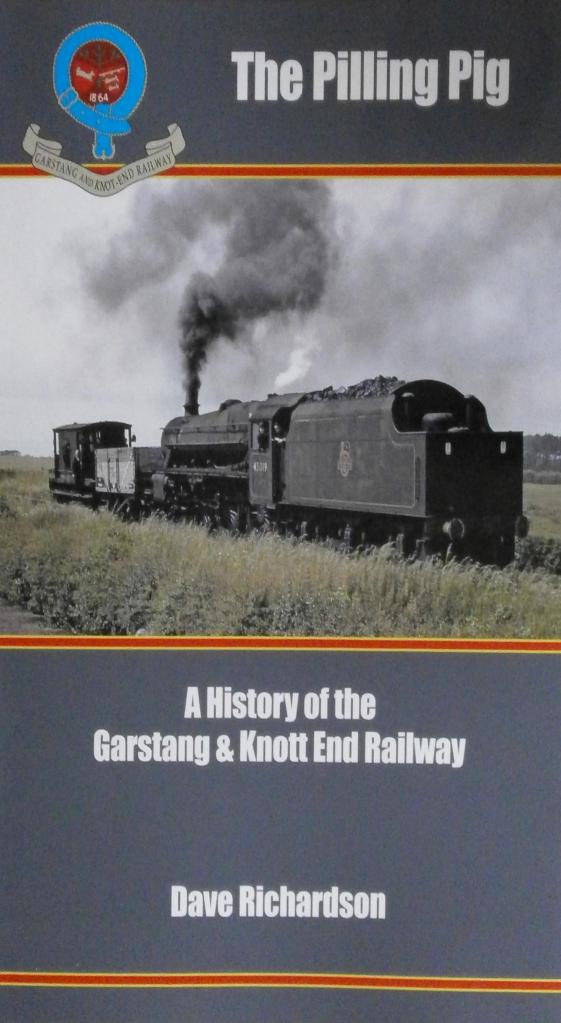
There is a superb set of photographs of the branch collated by Paul Johnson on smugmug.com. [5]
Locomotives
As promised in an earlier article about this line, here are some details of the locomotives that served the line in its early years before it was absorbed by the LMS. The basic details come from the Wikipedia article about the line: [8]
1870: Black, Hawthorn 0-4-2ST Hebe
“The line opened on December 5, 1870, running with a single locomotive, Black Hawthorn 0-4-2ST Hebe, passengers boarding any point along the line by request. … In 1872, Hebe broke down, with all services suspended, and soon the company was in rent arrears. The locomotive was repossessed, and for the next three years only occasional horse-drawn trains were run.” [9]
1874: Manning Wardle 0-4-0ST Union
“Services resumed in 1875 using a new locomotive, Manning Wardle 0-4-0ST Union.” [9]
1875: Hudswell Clarke 0-6-0ST Farmer’s Friend (alias “Pilling Pig”) [10: p73]
In the late 1870s, Farmer’s Friend, was given the nickname ‘Pilling Pig’ “because of the squeal made by its whistle. This name became colloquially applied to all of the line’s locomotives and even the railway itself.” [9] This locomotive was operational until 1900. [11]

1885: Hudswell Clarke 0-6-0ST Hope
This locomotive had larger cylinders than Farmer’s Friend (13×20 in rather than 11×17 in) but operated at the same boiler pressure (120 psi). [12]
1897: Hudswell Clarke 0-6-0ST Jubilee Queen

This locomotive had larger cylinders than Hope (15×20) and operated at a higher boiler pressure (140 psi). [12]
1900: Hudswell Clarke 0-6-0ST New Century
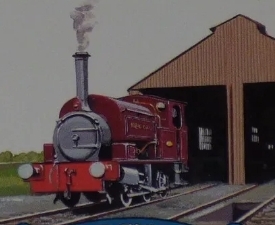
This loco was a sister loco to Jubilee Queen, and is recorded by Wells [14] as having been purchased at the same time.
1908: Manning Wardle 0-6-0T Knott End

This locomotive had 14×20 in cylinders and operated at 150 psi. [12]
1909: Manning Wardle 2-6-0T Blackpool

This loco had 16×22 in cylinders, operated at 150 psi, and had larger diameter driving wheels (48 in). It was fitted with Isaacson’s patent valve gear. [12][13][14] It was Works No. 1747. Isaacson, together with Edwin Wardle and Charles Edward Charlesworth took out payments for the valve gear in 1907 (patents No’s. 17533 and 27899 of 1907). Atkins is quoted by steamindex.com as saying that “The 2-6-0T was rare on British standard gauge railways. The only other was on the Wrexham, Mold and Connahs Quay Railway – a rebuild from an 0-6-0.” [15]
Other Rolling Stock
Railmotor
In 1920, just a couple of years before the line was absorbed by the new LMS, a railmotor was hired by the G&KE from the LNWR. It was still running on the line in March 1930 when the passenger service ceased. [22: p22] It looked after the majority of passenger services on the line. “Seating 48 third class passengers, this vehicle originally operated in LNWR colours, but was later repainted in LMS red with the number 10698.” [22: p24-25] The last passenger service actually ran on Saturday 29th March, although the formal closure took effect before traffic started on Monday 31st March 1930. [22: p25]

Coaches
The six postcards published by Dalkeith [16] include one showing coaching stock on the line. It is shown below:

When the full line was completed to Knott End, eight bogie coaches were supplied by Birmingham Carriage and Wagon Co. Ltd. Since the bogie coaches had no guards compartment they originally worked with the goods brake vans, but in 1909 two new passenger brake vans were introduced.
After the removal.of passenger service from the Garstang to Knott End (G&KE) Railway, it seems that one or two items of rolling stock were transferred to the Wanlockhead branch of the Caledonian Railway in the 1930s. That line was originally the ‘Leadhills and Wanlockhead Light Railway’. [17] A thread on the Caledonian Railway Association Forum [18] explores what is known by members of that Forum.
Apparently, “In the early 1930s a composite coach with end roofed platforms was transferred from the Garstang and Knott End Railway to the Wanlockhead branch. Its LMS number was 17899.” [18]
It appears that “a G&KE 4 wheeled passenger brake van transferred at the same time.” [17]
It was scrapped at the same time as the bogie coach when the Wanlockhead line closed in 1939.[20]
There was an article about the construction, in 7mm/ft (O Gauge), of the two carriages in Model Railway News in October 1959. That article is produced in full below. [19]
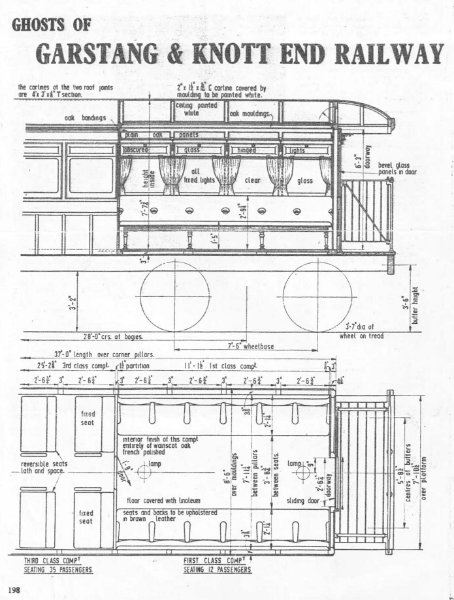



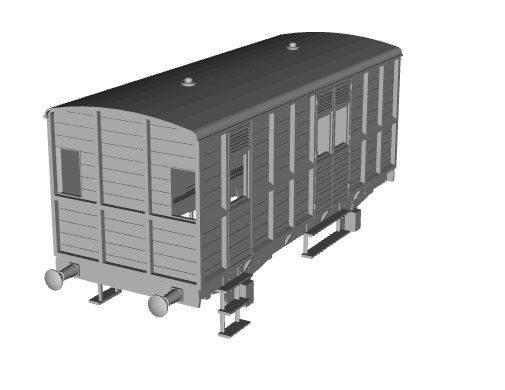
Apparently, 6 of the 8 G&KE coaches “fetched up at the LMS Carriage depot at Slateford, where they were used as offices and stores until at least 1959.” [17]
Wagons
One of the postcards in the Dalkeith series shows wagons used on the line. One of these is covered above. There were two dedicated coaching brake wagons. In the image below the goods wagons are in grey and the coaching brake in deep red. [16]
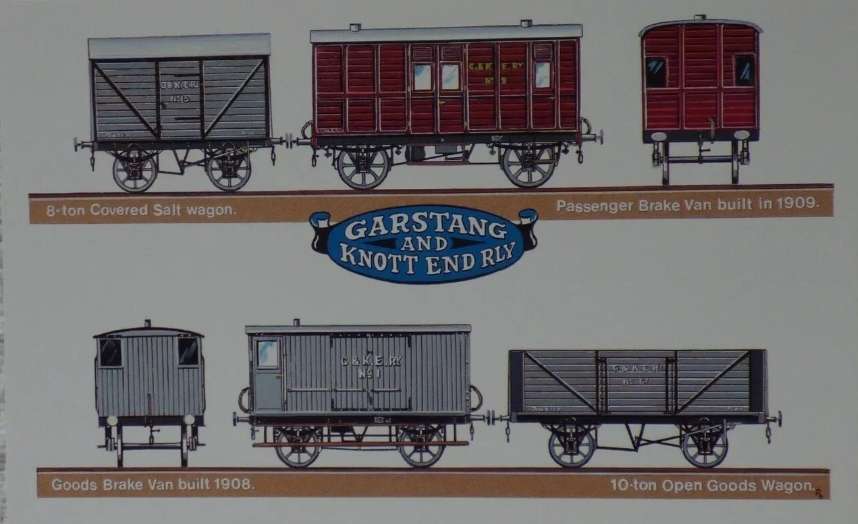
Drawings of G&KE Railway wagons can be found here. [21]
References
- R. Supwards and Douglas Robinson; A Pig of a Job; in Railway Bylines; The Irwell Press, March 2002, p196-200.
- https://www.nwemail.co.uk/features/17492880.new-book-tells-story-garstangs-pilling-pig-railway, accessed on 7th December 2023.
- https://m.facebook.com/groups/428057400895737/permalink/1459373981097402, accessed on 7th December 2023.
- Dave Richardson; The Pilling Pig: A History of the Garstang & Knott End Railway; Cumbria Railways Association, 2019.
- https://transportsofdelight.smugmug.com/RAILWAYS/LOCOMOTIVES-OF-THE-LMS-CONSTITUENT-COMPANIES/GARSTANG-KNOTT-END-RAILWAY, accessed on 7th December 2023.
- https://m.facebook.com/groups/428057400895737/permalink/471089033259240, accessed on 7th December 2023.
- https://m.facebook.com/groups/428057400895737/permalink/474074486294028, accessed on 7th December 2023.
- https://en.m.wikipedia.org/wiki/Garstang_and_Knot-End_Railway, accessed on 9th December 2023.
- https://www.heritagerailway.co.uk/2796/group-embarks-on-garstang-knot-end-revival, accessed on 9th December 2023.
- T.R. Perkins; The Garstang & Knot-End Railway; in The Railway Magazine, January 1908, p72–77.
- https://www.steamlocomotive.com/locobase.php?country=Great_Britain&wheel=0-6-0&railroad=gke#20440, accessed on 9th December 2023.
- https://jdhsmith.math.iastate.edu/term/slgbgker.htm, accessed on 9th December 2023.
- Frank K. Walmesley; The Garstang & Knot-End Railway; in The Railway Magazine Volume 22, December 1959, p859–864
- Jeffrey Wells; The Pig and Whistle railway: a Lancashire backwater; in BackTrack Volume 7, September 1993, p257–265; a summary is provided on steamindex.com: https://steamindex.com/backtrak/bt7.htm#1993-5, accessed on 9th December 2023.
- Philip Atkins; Blackpool – Britain’s most obscure locomotive; in Backtrack Volume 10, January 1996, p40-42; a summary is provided on steamindex.com: https://steamindex.com/backtrak/bt10.htm#10-40 accessed on 9th December 2023.
- Dalkeith prodiced a series of 6 postcards. A set all 6 cards was for sale on eBay: https://www.ebay.co.uk/itm/195276709484?mkcid=16&mkevt=1&mkrid=711-127632-2357-0&ssspo=eqi-iQs2SYu&sssrc=4429486&ssuid=afQhrar7TGK&var=&widget_ver=artemis&media=COPY, accessed on 9th December 2023.
- Alastair Ireland; The Leadhills and Wanlockhead Light Railway; privately published in 1996.
- https://www.crassoc.org.uk/forum/viewtopic.php?t=1608, accessed on 9th December 2023.
- N.S. Eagles; Ghosts of Garstang & Knott End Railway; in Model Railway News, October 1959, p198-199.
- https://www.rue-d-etropal.com/3D-printing/passenger-stock-lt/3d_printed_light-railway-stock.htm#garstang,vaccessed on 9th December 2023.
- https://igg.org.uk/rail/00-app2/lms/gker.htm, accessed on 10th December 2023.
- W. Rush & M.R. Connor-Price; The Garstang & Knott End Railway; Oakwood Press, 1985.
- https://www.railscot.co.uk/img/60/981/, accessed on 11th December 2023.

